The Impact of Building Orientation and Window-to-Wall Ratio on the Performance of Electrochromic Glazing in Hot Arid Climates: A Parametric Assessment
Abstract
:1. Introduction
| Processes | Advantages | Disadvantages | References |
|---|---|---|---|
| Electrode position |
| Material preparation and post-processes (drying, annealing) require:
| [14,15,16] |
| Sol–gel |
|
| [10,17,18,19] |
| Spray pyrolysis |
|
| [20,21,22] |
| Chemical vapor deposition (CVD) |
|
| [11,13,23,24], |
| Physical vapor deposition (PVD) |
|
| [11,12,25,26,27] |
| Sputtering |
|
| [28,29,30] |
| Nanoparticle deposition system (NPDS) |
|
| [31,32,33,34] |
2. Materials and Methods
2.1. Climatic Condition
2.2. Building Description
2.3. Simulation Data
- 18 °C setpoint temperature for heating.
- 26 °C setpoint temperature for cooling.
- 300 lux limit for lighting (illuminance level).
3. Results and Discussion
4. Conclusions
Author Contributions
Funding
Institutional Review Board Statement
Informed Consent Statement
Data Availability Statement
Conflicts of Interest
Nomenclature
| EC | Electrochromic |
| CVD | Chemical vapor deposition |
| PVD | Physical vapor deposition |
| NPDS | Nanoparticle deposition system |
| WWR | Window-to-wall ratio |
| Low-e | Low emissivity |
| WO3 | Tungsten trioxide |
| NiO | Nickel oxide |
| SHGC | Solar heat coefficient |
| Tvis | Visible light transmittance |
| U-values | Thermal transmittance |
| PVB | Polyvinyl butyral |
| EPW file | EnergyPlus weather file |
| IDF | Input data file |
| COP | Coefficient of performance |
References
- Gyamfi, S.; Krumdieck, S.; Urmee, T. Residential peak electricity demand response—Highlights of some behavioural issues. Renew. Sustain. Energy Rev. 2013, 25, 71–77. [Google Scholar] [CrossRef] [Green Version]
- Van, L.P.; Malyavina, E.G.; Malikova, O.Y. Impact of Glass Window to Heat Load in Office Building in Different Climates. In IOP Conference Series: Materials Science and Engineering; IOP Publishing: Bristol, UK, 2021; Volume 1079, p. 042084. [Google Scholar] [CrossRef]
- Chiffres Clés du Bilan Energetique de L’année 2017. Available online: https://www.energy.gov.dz/?article=bilan-energetique-national-du-secteur (accessed on 1 May 2022).
- Granqvist, C.G. Recent progress in thermochromics and electrochromics: A brief survey. Thin Solid Film. 2016, 614, 90–96. [Google Scholar] [CrossRef]
- Granqvist, C.G. Electrochromics for smart windows: Oxide-based thin films and devices. Thin Solid Film. 2014, 564, 1–38. [Google Scholar] [CrossRef]
- Casini, M. Active dynamic windows for buildings: A review. Renew. Energy 2018, 119, 923–934. [Google Scholar] [CrossRef]
- Piccolo, A.; Simone, F. Performance requirements for electrochromic smart window. J. Build. Eng. 2015, 3, 94–103. [Google Scholar] [CrossRef]
- Monk, P.; Mortimer, R.; Rosseinsky, D. Electrochromism and Electrochromic Devices; Cambridge University Press: Cambridge, UK, 2007; Volume 1, pp. 1–24. [Google Scholar] [CrossRef]
- Park, S.-I.; Quan, Y.-J.; Kim, S.-H.; Kim, H.; Kim, S.; Chun, D.-M.; Lee, C.S.; Taya, M.; Chu, W.-S.; Ahn, S.-H. A review on fabrication processes for electrochromic devices. Int. J. Precis. Eng. Manuf.-Green Technol. 2016, 3, 397–421. [Google Scholar] [CrossRef]
- Pierre, A.C. Introduction to Sol-Gel Processing; Springer Science & Business Media: Cham, Switzerland, 2013; Volume 1. [Google Scholar]
- Ilangovan, R.; Subha, V.; Ravindran, R.E.; Kirubanandan, S.; Renganathan, S. Nanomaterials: Synthesis, physicochemical characterization, and biopharmaceutical applications. In Nanoscale Processing; Elsevier: Amsterdam, The Netherlands, 2021; pp. 33–70. [Google Scholar]
- Devasia, R.; Painuly, A.; Devapal, D.; Sreejith, K.J. Continuous fiber reinforced ceramic matrix composites. In Fiber Reinforced Composites; Woodhead Publishing: Sawston, UK, 2021; pp. 669–751. [Google Scholar]
- Creighton, J.R.; Ho, P. Introduction to chemical vapor deposition (CVD). Chem. Vap. Depos. 2001, 2, 1–22. [Google Scholar]
- Yuan, Y.F.; Xia, X.H.; Wu, J.B.; Chen, Y.B.; Yang, J.L.; Guo, S.Y. Enhanced electrochromic properties of ordered porous nickel oxide thin film prepared by self-assembled colloidal crystal template-assisted electrodeposition. Electrochim. Acta 2011, 56, 1208–1212. [Google Scholar] [CrossRef]
- Sonavane, A.C.; Inamdar, A.I.; Shinde, P.S.; Deshmukh, H.P.; Patil, R.S.; Patil, P.S. Efficient electrochromic nickel oxide thin films by electrodeposition. J. Alloy. Compounds 2010, 489, 667–673. [Google Scholar] [CrossRef]
- Zhang, J.; Tu, J.P.; Cai, G.F.; Du, G.H.; Wang, X.L.; Liu, P.C. Enhanced electrochromic performance of highly ordered, macroporous WO3 arrays electrodeposited using polystyrene colloidal crystals as template. Electrochim. Acta 2013, 99, 1–8. [Google Scholar] [CrossRef]
- Zarzycki, J. Past and present of sol-gel science and technology. J. Sol-Gel Sci. Technol. 1997, 8, 17–22. [Google Scholar] [CrossRef]
- Scherer, G.W. Sintering of sol-gel films. J. Sol-Gel Sci. Technol. 1997, 8, 353–363. [Google Scholar] [CrossRef]
- Dimitriev, Y.; Ivanova, Y.; Iordanova, R. History of sol-gel science and technology. J. Univ. Chem. Technol. Metall. 2008, 43, 181–192. [Google Scholar] [CrossRef]
- Mukherjee, R.; Sahay, P.P. Improved electrochromic performance in sprayed WO3 thin films upon Sb doping. J. Alloy. Compd. 2016, 660, 336–341. [Google Scholar] [CrossRef]
- Mousavi, M.; Kompany, A.; Shahtahmasebi, N.; Bagheri-Mohagheghi, M.M. The effect of solution concentration on the physical and electrochemical properties of vanadium oxide films deposited by spray pyrolysis. J. Semicond. 2013, 34, 103001. [Google Scholar] [CrossRef]
- Bertus, L.M.; Enesca, A.; Duta, A. Influence of spray pyrolysis deposition parameters on the optoelectronic properties of WO3 thin films. Thin Solid Film. 2012, 520, 4282–4290. [Google Scholar] [CrossRef]
- Obraztsov, A.N.; Obraztsova, E.A.; Tyurnina, A.V.; Zolotukhin, A.A. Chemical vapor deposition of thin graphite films of nanometer thickness. Carbon 2007, 45, 2017–2021. [Google Scholar] [CrossRef]
- Chandrakala, M.; Bharath, S.R.; Maiyalagan, T.; Arockiasamy, S. Synthesis, crystal structure and vapour pressure studies of novel nickel complex as precursor for NiO coating by metalorganic chemical vapour deposition technique. Mater. Chem. Phys. 2017, 201, 344–353. [Google Scholar] [CrossRef]
- Chiu, P.K.; Chiang, D.; Lee, C.T.; Hsiao, C.N.; Yang, J.R.; Cho, W.H.; Huang, C.L. Investigation of the Microstructure, Porosity, Adhesion, and Optical Properties of a WO3 Film Fabricated Using an E-Beam System with Ion Beam-Assisted Deposition. IEEE Trans. Magn. 2014, 50, 3500204. [Google Scholar] [CrossRef]
- Selvakumar, N.; Barshilia, H.C. Review of physical vapor deposited (PVD) spectrally selective coatings for mid-and high-temperature solar thermal applications. Sol. Energy Mater. Sol. Cells 2012, 98, 1–23. [Google Scholar] [CrossRef]
- Tajima, K.; Yamada, Y.; Okada, M.; Yoshimura, K. Fabrication study of proton injection layer suitable for electrochromic switchable mirror glass. Thin Solid Film. 2010, 519, 934–937. [Google Scholar] [CrossRef]
- Kubo, T.; Nishikitani, Y.; Sawai, Y.; Iwanaga, H.; Sato, Y.; Shigesato, Y. Electrochromic properties of Li x Ni y O films deposited by RF magnetron sputtering. J. Electrochem. Soc. 2009, 156, 629. [Google Scholar] [CrossRef]
- Chu, C.H.; Wu, H.W.; Huang, J.L. Novel WO3-Based Electrochromic Device for High Optical Modulation and Infrared Suppression. IEEE Electron Device Lett. 2015, 36, 256–258. [Google Scholar] [CrossRef]
- Tajima, K.; Yamada, Y.; Okada, M.; Yoshimura, K. Accelerated degradation studies on electrochromic switchable mirror glass based on magnesium–nickel thin film in simulated environment. Sol. Energy Mater. Sol. Cells 2010, 94, 1716–1722. [Google Scholar] [CrossRef]
- Kim, H.; Park, Y.; Choi, D.; Ahn, S.H.; Lee, C.S. Novel fabrication of an electrochromic antimony-doped tin oxide film using a nanoparticle deposition system. Appl. Surf. Sci. 2016, 377, 370–375. [Google Scholar] [CrossRef]
- Kim, M.S.; Chun, D.M.; Choi, J.O.; Lee, J.C.; Kim, Y.H.; Kim, K.S.; Ann, S.H. Dry-spray deposition of TiO2 for a flexible dye-sensitized solar cell (DSSC) using a nanoparticle deposition system (NPDS). J. Nanosci. Nanotechnol. 2012, 12, 3384–3388. [Google Scholar] [CrossRef]
- Chun, D.M.; Kim, C.S.; Choi, J.O.; Lee, G.Y.; Lee, C.S.; Ahn, S.H. Multilayer deposition of ceramic and metal at room temperature using nanoparticle deposition system (NPDS) and planarization process. Int. J. Adv. Manuf. Technol. 2014, 72, 41–46. [Google Scholar] [CrossRef]
- Kim, H.; Yang, S.; Ahn, S.H.; Lee, C.S. Effect of particle size on various substrates for deposition of NiO film via nanoparticle deposition system. Thin Solid Film. 2016, 600, 109–118. [Google Scholar] [CrossRef]
- Mehaoued, K.; Lartigue, B. Influence of a reflective glass façade on surrounding microclimate and building cooling load: Case of an office building in Algiers. Sustain. Cities Soc. 2019, 46, 101443. [Google Scholar] [CrossRef]
- Leskovar, V.Ž.; Premrov, M. An approach in architectural design of energy-efficient timber buildings with a focus on the optimal glazing size in the south-oriented façade. Energy Build. 2011, 43, 3410–3418. [Google Scholar] [CrossRef]
- Hassouneh, K.; Alshboul, A.; Al-Salaymeh, A. Influence of windows on the energy balance of apartment buildings in Amman. Energy Convers. Manag. 2010, 51, 1583–1591. [Google Scholar] [CrossRef]
- Friess, W.A.; Rakhshan, K. A review of passive envelope measures for improved building energy efficiency in the UAE. Renew. Sustain. Energy Rev. 2017, 72, 485–496. [Google Scholar] [CrossRef]
- Yang, Q.; Liu, M.; Shu, C.; Mmereki, D.; Hossain, U.; Zhan, X. Impact analysis of window-wall ratio on heating and cooling energy consumption of residential buildings in hot summer and cold winter zone in China. J. Eng. 2015, 2015, 538254. [Google Scholar] [CrossRef] [Green Version]
- He, Q.; Ng, S.T.; Hossain, M.; Skitmore, M. Energy-efficient window retrofit for high-rise residential buildings in different climatic zones of China. Sustainability 2019, 11, 6473. [Google Scholar] [CrossRef] [Green Version]
- Sibilio, S.; Rosato, A.; Scorpio, M.; Iuliano, G.; Ciampi, G.; Vanoli, G.P.; de Rossi, F. A review of electrochromic windows for residential applications. Int. J. Heat Technol. 2016, 34, S481–S488. [Google Scholar] [CrossRef]
- Piccolo, A. Thermal performance of an electrochromic smart window tested in an environmental test cell. Energy Build. 2010, 42, 1409–1417. [Google Scholar] [CrossRef]
- Aste, N.; Compostella, J.; Mazzon, M. Comparative energy and economic performance analysis of an electrochromic window and automated external venetian blind. Energy Procedia 2012, 30, 404–413. [Google Scholar] [CrossRef] [Green Version]
- Cannavale, A.; Martellotta, F.; Cossari, P.; Gigli, G.; Ayr, U. Energy savings due to building integration of innovative solid-state electrochromic devices. Appl. Energy 2018, 225, 975–985. [Google Scholar] [CrossRef]
- Sbar, N.L.; Podbelski, L.; Yang, H.M.; Pease, B. Electrochromic dynamic windows for office buildings. Int. J. Sustain. Built Environ. 2012, 1, 125–139. [Google Scholar] [CrossRef] [Green Version]
- Aldawoud, A. Conventional fixed shading devices in comparison to an electrochromic glazing system in hot, dry climate. Energy Build. 2013, 59, 104–110. [Google Scholar] [CrossRef]
- Piccolo, A.; Marino, C.; Nucara, A.; Pietrafesa, M. Energy performance of an electrochromic switchable glazing: Experimental and computational assessments. Energy Build. 2018, 165, 390–398. [Google Scholar] [CrossRef]
- Lahmar, I.; Zemmouri, N.; Cannavale, A.; Martellotta, F. Investigating the impact of electrochromic glazing on energy performance in hot arid climate using parametric design. In IOP Conference Series: Materials Science and Engineering; IOP Publishing: Bristol, UK, 2019; Volume 609, p. 062027. [Google Scholar] [CrossRef] [Green Version]
- Tavares, P.F.; Gaspar, A.R.; Martins, A.G.; Frontini, F. Evaluation of electrochromic windows impact in the energy performance of buildings in Mediterranean climates. Energy Policy 2014, 67, 68–81. [Google Scholar] [CrossRef] [Green Version]
- Kottek, M.; Grieser, J.; Beck, C.; Rudolf, B.; Rubel, F. World map of the Köppen-Geiger climate classification updated. Meteorol. Z. 2006, 15, 259–263. [Google Scholar] [CrossRef]
- EPW File. Available online: https://climate.onebuilding.org/WMO_Region_1_Africa/DZA_Algeria/index.html (accessed on 1 May 2022).
- Hadjij, C. Famille, logement, propriété à Alger. Insaniyat. Rev. Algérienne D’anthropologie Et De Sci. Soc. 1998, 4, 99–107. [Google Scholar] [CrossRef]
- Vacuum Glazing. Available online: https://www.vacuum-glass.com/vacuum-insulating-glass-price-costs/ (accessed on 14 May 2022).
- Will Smart Glass come to windows and doors? Available online: https://www.aluminiumtradesupply.co.uk/12549/will-smart-glass-come-windows-doors/ (accessed on 14 May 2022).
- SageGlass. Available online: https://www.sageglass.com/en/products/sageglass (accessed on 14 May 2022).
- LBNL Window 7.5. Available online: https://windows.lbl.gov/tools/window/software-download (accessed on 14 May 2022).
- Lomas, K.J. Empirical validation of building energy simulation programs. Fuel Energy 1997, 26, 253–275. [Google Scholar] [CrossRef]
- Toutou, A.; Fikry, M.; Mohamed, W. The parametric based optimization framework daylighting and energy performance in residential buildings in hot arid zone. Alex. Eng. J. 2018, 57, 3595–3608. [Google Scholar] [CrossRef]
- Silvero, F.; Rodrigues, F.; Montelpare, S. A parametric study and performance evaluation of energy retrofit solutions for buildings located in the hot-humid climate of Paraguay—sensitivity analysis. Energies 2019, 12, 427. [Google Scholar] [CrossRef] [Green Version]
- Bre, F.; Silva, A.S.; Ghisi, E.; Fachinotti, V.D. Residential building design optimisation using sensitivity analysis and genetic algorithm. Energy Build. 2016, 133, 853–866. [Google Scholar] [CrossRef]
- Handbook, A.F. Chapter 31: Energy Estimating and Modeling Methods; American Society of Heating, Refrigerating, and Air-Conditioning Engineers: Atlanta, GA, USA, 2001. [Google Scholar]
- Al-Saadi, S.N.; Al-Hajri, J.; Sayari, M.A. Energy-efficient retrofitting strategies for residential buildings in hot climate of Oman. Energy Procedia 2017, 142, 2009–2014. [Google Scholar] [CrossRef]
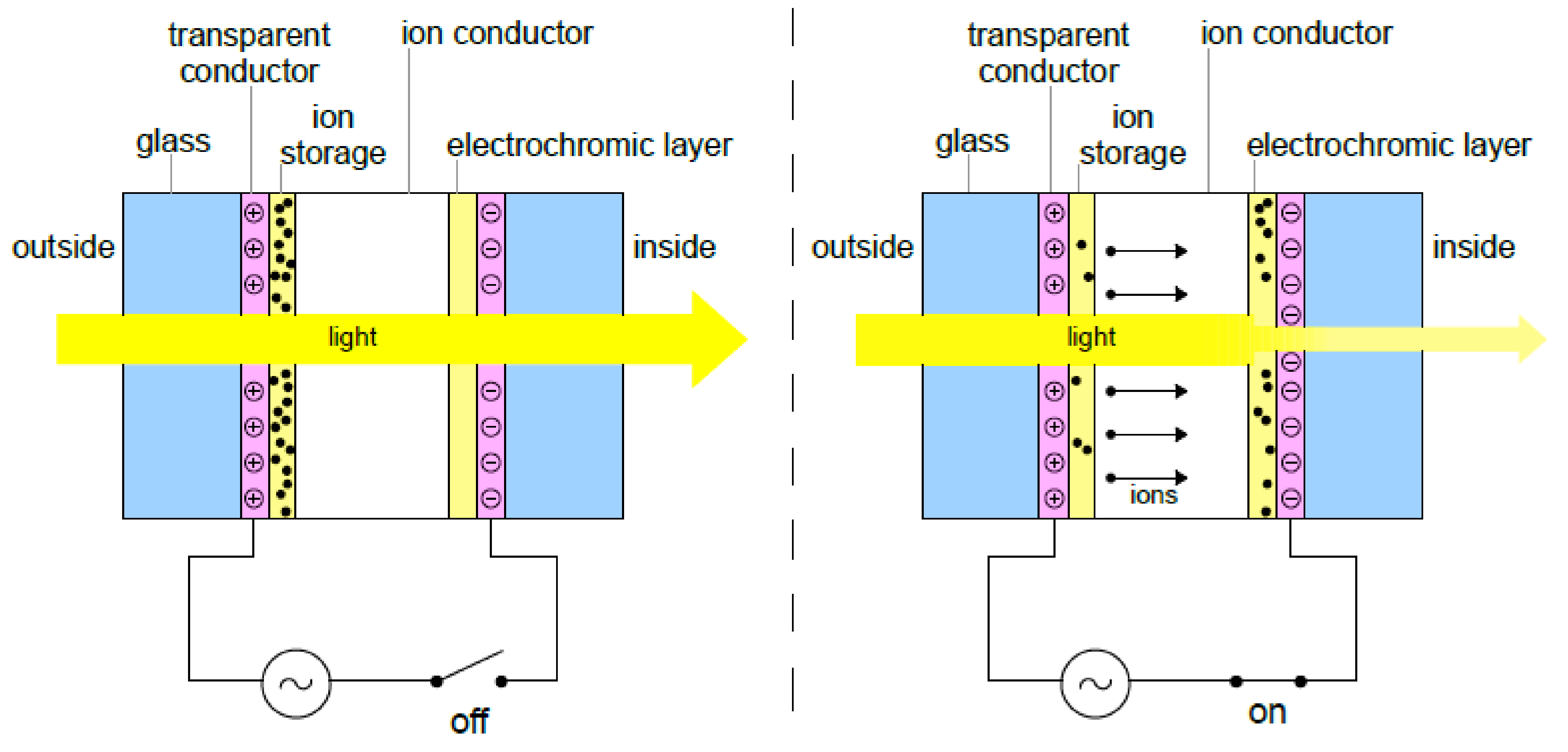

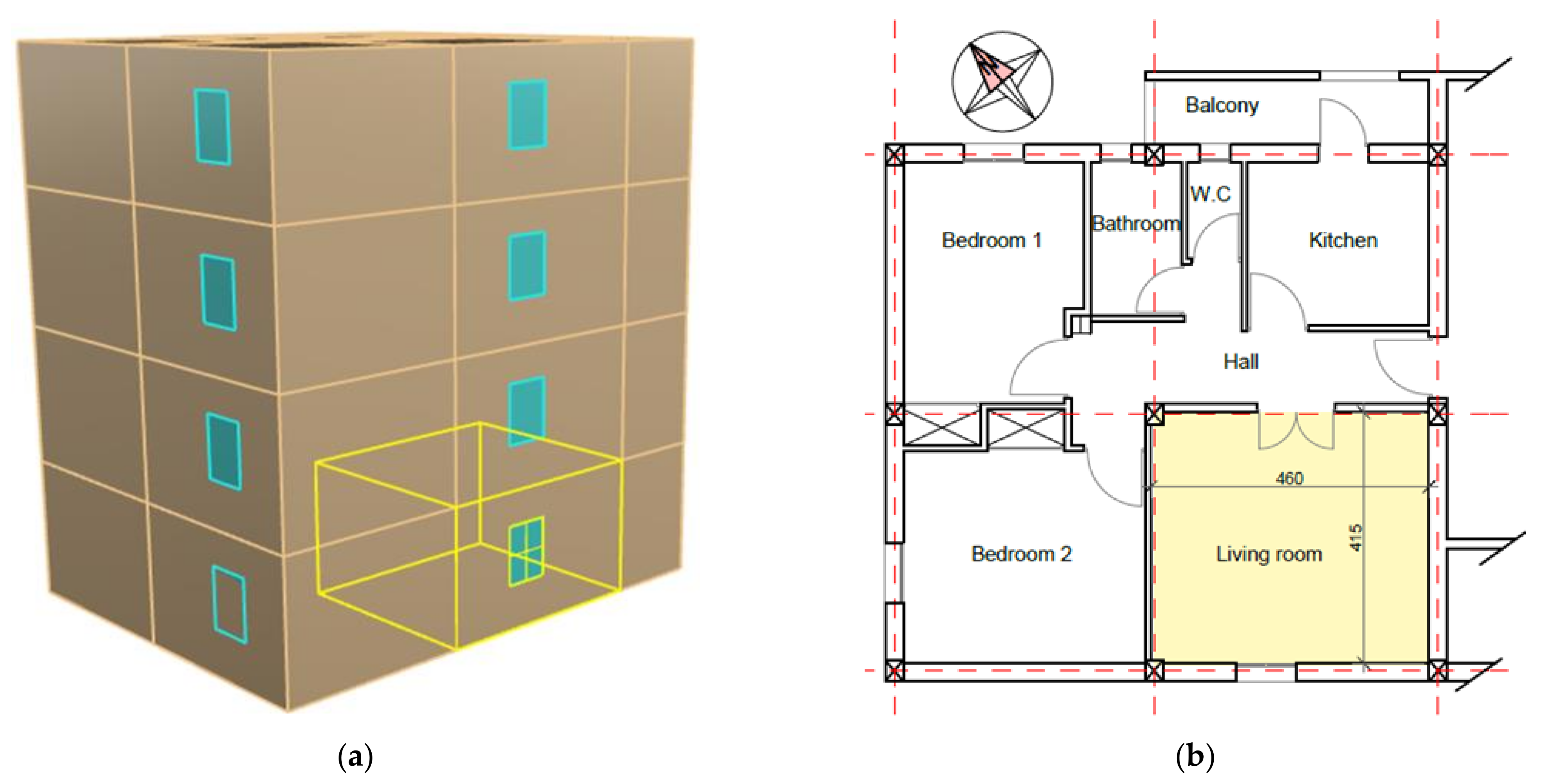



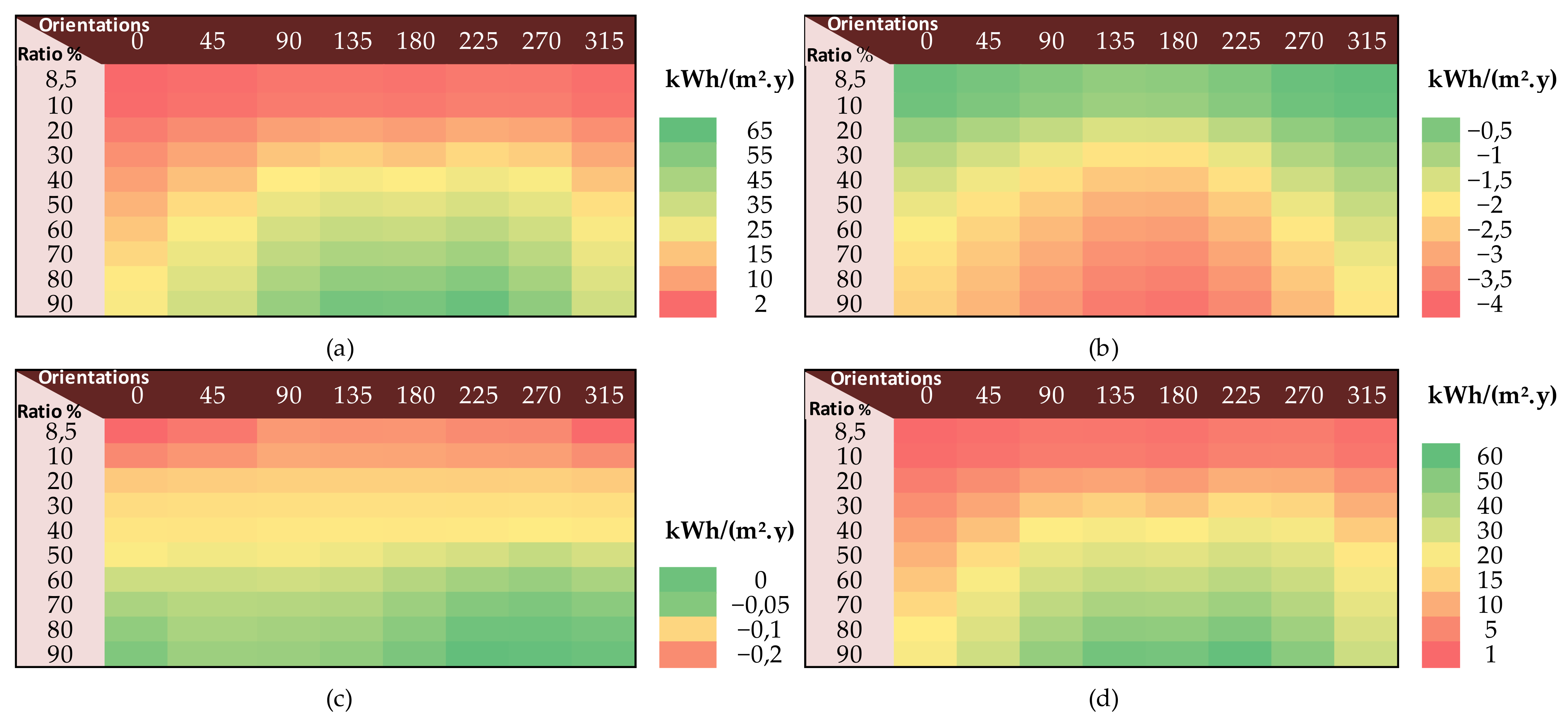
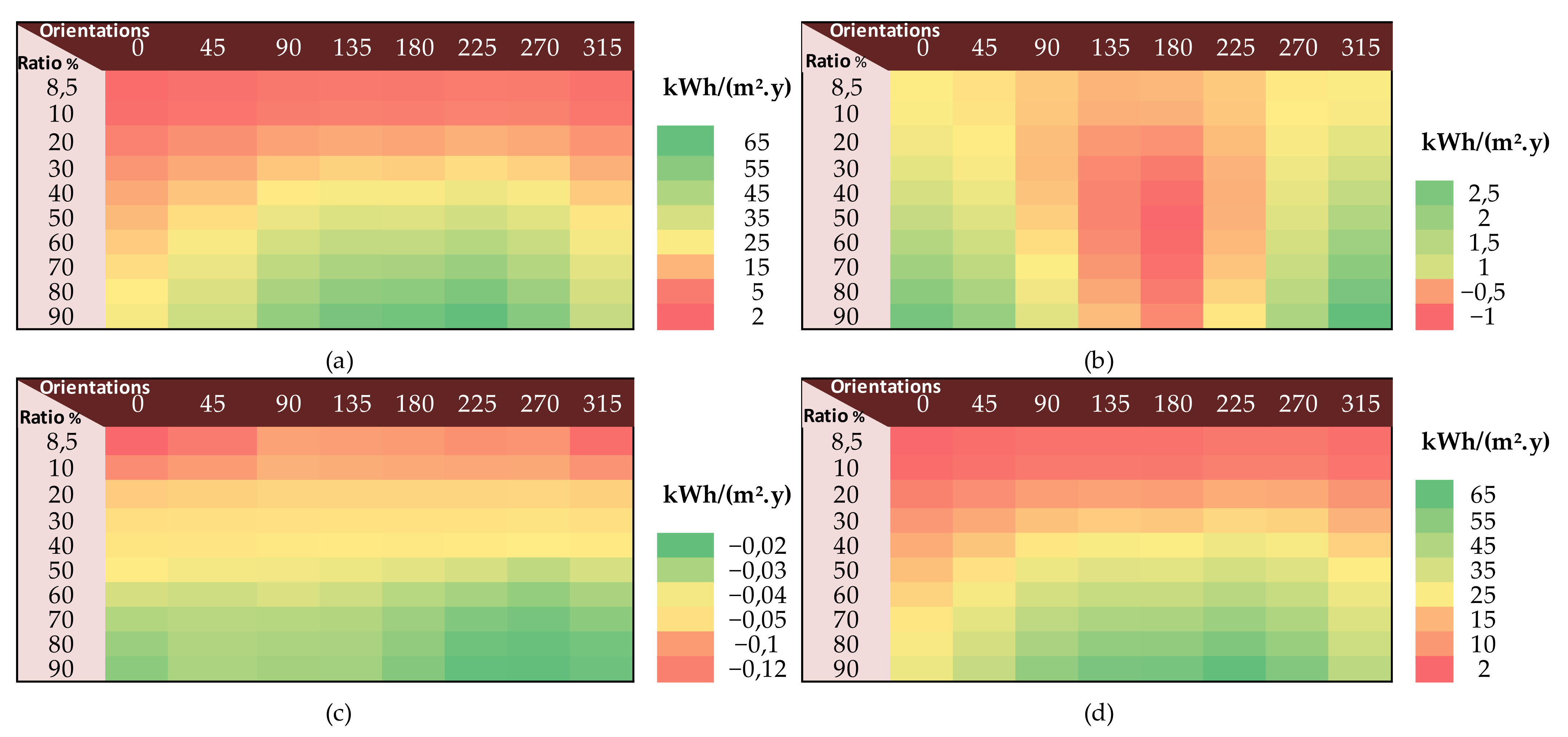
| Materials Thickness | Thermal Properties U-value (W/(m²∙K)) | Front Mass (kg/m²) | |
|---|---|---|---|
| Exterior Wall | 0.02 m cement plaster | 1.14 | 329 |
| 0.15 m hollow brick | |||
| 0.05 m air barrier | |||
| 0.1 m hollow brick | |||
| 0.01 m coated plaster | |||
| Interior Wall | 0.01 m coated plaster | 2.49 | 188 |
| 0.1 m hollow brick | |||
| 0.01 m coated plaster | |||
| Roof | 0.02 m flooring | 2.42 | 537 |
| 0.04 m mortar | |||
| 0.16 m concrete blocks hollow | |||
| 0.04 m concrete slab | |||
| 0.01 m coated plaster | |||
| Floor | 0.15 m clay | 2.25 | 809 |
| 0.15 m stones of valley | |||
| 0.04 m concrete slab | |||
| 0.04 m mortar | |||
| 0.02 m flooring |
| Windows | Laminated Glazing | Double Vacuum Glazing | EC Glazing | |
|---|---|---|---|---|
| Structure diagram |  | 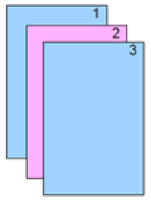 |  | |
| Materials thickness | Layer 1 | 3.1 mm clear glass | 5.7 mm clear glass | 5.7 mm clear glass |
| Layer 2 | 1.05 mm PVB color film | 0.1 mm vacuum | 12 mm air space | |
| Layer 3 | 3.1 mm clear glass | 5.7 mm clear glass | 7 mm sage glass | |
| Thermal and optical properties U-value (W/(m²∙K)) | U-value | 5.64 | 2.2 | 1.9 |
| SHGC | 0.65 | 0.70 | 0.44 (0.10) | |
| Tvis | 0.68 | 0.78 | 0.64 (0.01) | |
| Characteristics | Description of the Base Case |
|---|---|
| location | Biskra, Algeria34.80° N/ 5.73° E/82 m |
| building azimuth | 225° (southwest) |
| plan shape | rectangular 4.6 × 4.15 m |
| setpoint temperature for heating | 18 °C |
| setpoint temperature for cooling | 26 °C |
| limit for lighting | 300 lux |
| occupied period | 12 p.m.–12 a.m. |
| infiltration | 0.0003 m3/(s∙m²) |
| internal heat gain | 1 Tv, 4 people, 2 LED lights |
| equipment load | 5 W/m² |
| lighting density | 5 W/m² |
| occupancy density | 4 persons |
| weather file | EnergyPlus weather file |
| COP | 2.7 |
Publisher’s Note: MDPI stays neutral with regard to jurisdictional claims in published maps and institutional affiliations. |
© 2022 by the authors. Licensee MDPI, Basel, Switzerland. This article is an open access article distributed under the terms and conditions of the Creative Commons Attribution (CC BY) license (https://creativecommons.org/licenses/by/4.0/).
Share and Cite
Lahmar, I.; Cannavale, A.; Martellotta, F.; Zemmouri, N. The Impact of Building Orientation and Window-to-Wall Ratio on the Performance of Electrochromic Glazing in Hot Arid Climates: A Parametric Assessment. Buildings 2022, 12, 724. https://doi.org/10.3390/buildings12060724
Lahmar I, Cannavale A, Martellotta F, Zemmouri N. The Impact of Building Orientation and Window-to-Wall Ratio on the Performance of Electrochromic Glazing in Hot Arid Climates: A Parametric Assessment. Buildings. 2022; 12(6):724. https://doi.org/10.3390/buildings12060724
Chicago/Turabian StyleLahmar, Imene, Alessandro Cannavale, Francesco Martellotta, and Noureddine Zemmouri. 2022. "The Impact of Building Orientation and Window-to-Wall Ratio on the Performance of Electrochromic Glazing in Hot Arid Climates: A Parametric Assessment" Buildings 12, no. 6: 724. https://doi.org/10.3390/buildings12060724
APA StyleLahmar, I., Cannavale, A., Martellotta, F., & Zemmouri, N. (2022). The Impact of Building Orientation and Window-to-Wall Ratio on the Performance of Electrochromic Glazing in Hot Arid Climates: A Parametric Assessment. Buildings, 12(6), 724. https://doi.org/10.3390/buildings12060724









